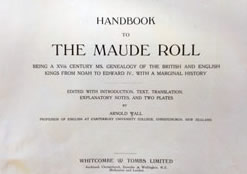With limited resources available to him, Wall successfully identified the two scribal hands responsible for the bulk of the Roll's text (today labelled the Lancastrian and Yorkist Scribes). He also identified a range of sources from which the Roll's text was drawn (Gildas, Nennius, Geoffrey of Monmouth, William of Malmesbury, Henry of Huntingdon, Gerald of Wales, William of Newburgh, Roger of Hoveden, and Ranulf Higden). It is also thanks to Wall's introduction that we know that the Roll originally ended in approximately 2 feet (610mm) of blank parchment. This blank section appears to have been removed at some point after 1919. It was probably originally intended to protect the manuscript when in storage.
Wall labelled the Roll's Latin as "monkish" and "very shocking to the Classical scholar". Partly, perhaps, because of Wall's lack of familiarity with medieval Latin, his edition contains a number of erroneous readings. It also contains omissions. These range from whole passages of commentary to the Roman numerals that were added to many of the roundels. The challenge of presenting the text in print also led to the omission of repeated and blank roundels, as well as to a degree of re-arrangement. Despite these issues, Wall's edition performed a valuable service: it was critical in ensuring that scholars outside Aotearoa New Zealand were able to access the Roll during the 20th and early 21st century. However, Wall made a number of assumptions about the Roll's origins that are today questionable and notably obscured the events that led up to its acquisition by Canterbury College.
The "Noah" Group
Wall assumed that the Roll was a unique item produced during the reign of Edward IV in a monastic environment. The first of these assumption was disproved by Alison Allan's pioneering research in the 1970s/80s. Allan identified the Canterbury Roll as part of what has become known as the "Noah" group, a series of rolls so named because of their starting point. Today, the majority of the "Noah" group manuscripts are held in British collections.
Other Manuscripts of the "Noah" Group
| Aberystwyth, National Library of Wales, Rolls 39 |
| Cambridge, King’s College, MS 43 |
| Lincoln, Lincolnshire Archives, 2-TDE/K/1 |
| London, British Library, Additional MS 18002 |
| London, British Library, Sloane MS 2732A |
| London, College of Arms, MS Box 28, no. 5 |
| London, College of Arms, MS Box 28, no. 12 |
| London, Society of Antiquaries of London, MS 570 |
| Notre Dame, University of Notre Dame, Hesburgh Library, cod. Lat. D. 3 |
| Oxford, Bodleian Library, Marshall MS 135 |
| Oxford, Queen’s College, MS 167 |


